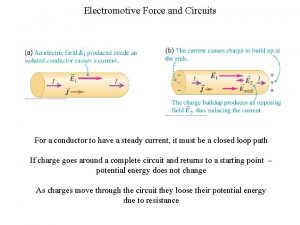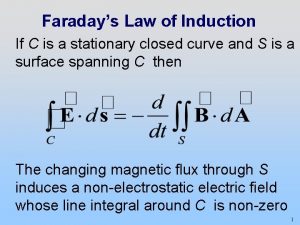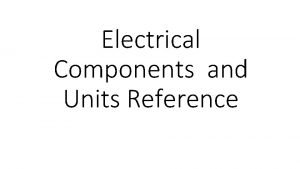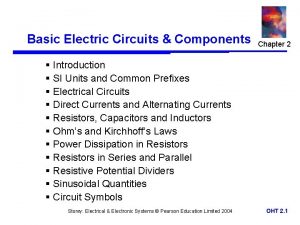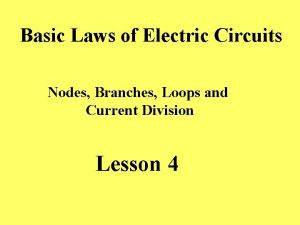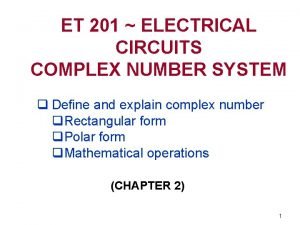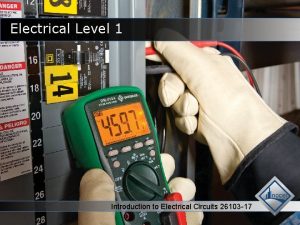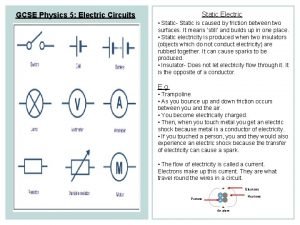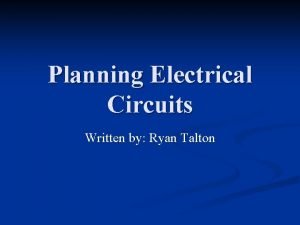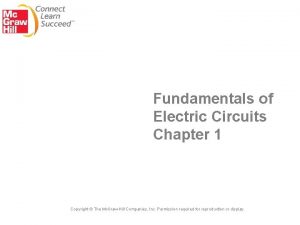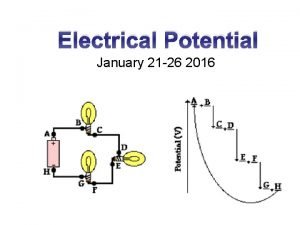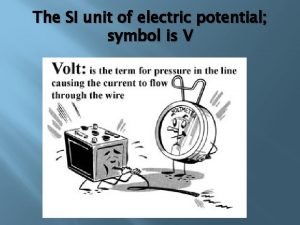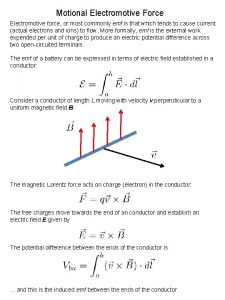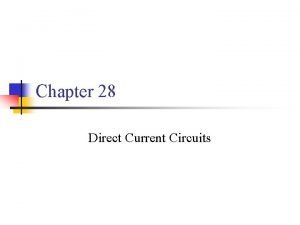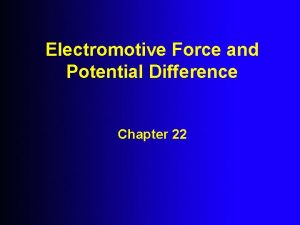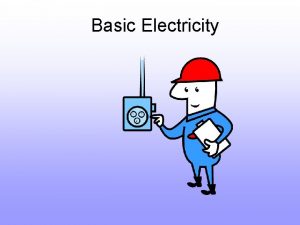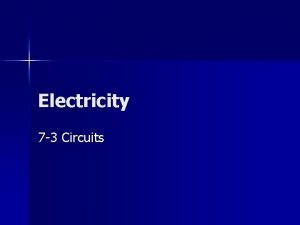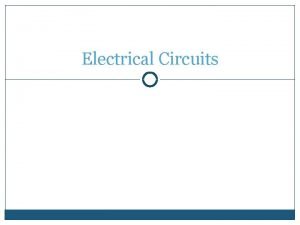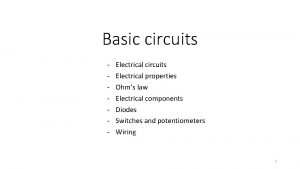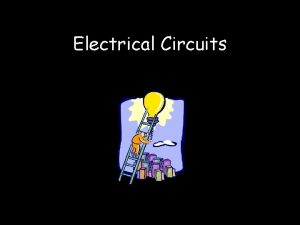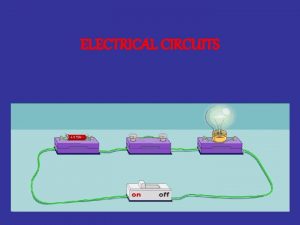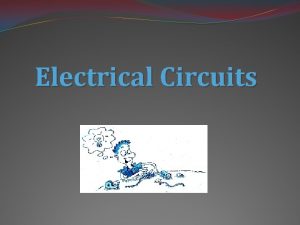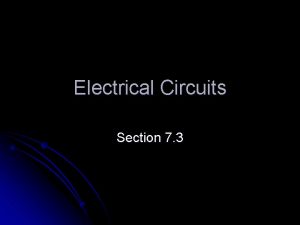DC Electrical Circuits Chapter 28 Electromotive Force Potential























- Slides: 23

DC Electrical Circuits Chapter 28 Electromotive Force Potential Differences Resistors in Parallel and Series Circuits with Capacitors

Resistors in Series a R 1 V 1 I c R 2 b V 2 The pair of resistors, R 1 and R 2, can be replaced by a single equivalent resistor R; one which, given I, has the same total voltage drop as the original pair. Note: the current I is the same, anywhere between a and b, but there is a voltage drop V 1 across R 1, and a voltage drop V 2 across R 2.

Resistors in Series a R 1 V 1 I R 2 b V 2 The pair of resistors can be replaced by a single equivalent resistor Req; one which, given I, has the same total voltage drop as the original pair. V = V 1 +V 2 = I R 1 +I R 2

Resistors in Series a R 1 V 1 I R 2 b V 2 The pair of resistors can be replaced by a single equivalent resistor Req; one which, given I, has the same total voltage drop as the original pair. V = V 1 +V 2 = I R 1 +I R 2 We want to write this as V= I Req

Resistors in Series a R 1 V 1 I R 2 b V 2 The pair of resistors can be replaced by a single equivalent resistor Req; one which, given I, has the same total voltage drop as the original pair. V = V 1 +V 2 = I R 1 +I R 2 We want to write this as V= I Req hence Req = R 1 + R 2

Resistors in Series a R 1 V 1 I R 2 b V 2 What is the voltage drop across each resistor ? V 1= I R 1 but I = V / (R 1 + R 2) V 1 = V R 1 / (R 1 + R 2) V 2= I R 2 but I = V / (R 1 + R 2) V 2 = V R 2 / (R 1 + R 2)

Resistors in Parallel R 1 a I I 1 I 2 R 2 b V Again find the equivalent single resistor which has the same V if I is given.

Resistors in Parallel R 1 a I I 1 I 2 R 2 b V Again find the equivalent single resistor which has the same V if I is given. Here the total I splits: I = I 1+I 2 = V / R 1 + V / R 2 = V(1/ R 1 +1/ R 2)

Resistors in Parallel R 1 a I I 1 I 2 R 2 b V Again find the equivalent single resistor which has the same V if I is given. Here the total I splits: I = I 1+I 2 = V / R 1 + V / R 2 = V(1/ R 1 +1/ R 2) We want to write this as: I = V / Req

Resistors in Parallel R 1 a I I 1 I 2 R 2 b V Again find the equivalent single resistor which has the same V if I is given. Here the total I splits: I = I 1+I 2 = V / R 1 + V / R 2 = V(1/ R 1 +1/ R 2) We want to write this as: I = V / Req Hence 1 / Req =1/ R 1 +1/ R 2

Parallel and Series Resistors Capacitors 1/R=1/R 1+1/R 2 C=C 1+C 2 R=R 1+R 2 1/C=1/C 1+1/C 2 Parallel Series

Batteries and Generators • Current is produced by applying a potential difference across a conductor (I=V/R) [This is not equilibrium so there is an electric field inside the conductor]. • This potential difference is set up by some source, such as a battery or generator [that generates charges, from some other type of energy, i. e. chemical, solar, mechanical]. • Conventionally an “applied voltage” is given the symbol E (units: volts). • For historical reasons, this applied voltage is often called the “electromotive force” (emf) [even though it’s not a force].

The Voltaic Pile Volta’s original battery Carbon Ag Zn wet cloth - + Zinc case - + electrical converter. . . . converts chemical energy to electrical energy Mixture of Ammonium Chloride& Manganese Dioxide

Electrical Description of a Battery I symbol E for battery + - R symbol for resistance • A battery does work on positive charges in moving them to higher potential (inside the battery). • The EMF E, most precisely, is the work per unit charge exerted to move the charges “uphill” (to the + terminal, inside) • . . . but you can just think of it as an “applied voltage. ” • Current will flow, in the external circuit, from the + terminal, to the – terminal, of the battery.

Resistors in Series R 1 + - I R 2 E Given Req = R 1 + R 2, the current is I=E/(R 1 + R 2) One can then work backwards to get the voltage across each resistor:

Resistors in Series R 1 + - I R 2 E Given Req = R 1 + R 2, the current is I=E/(R 1 + R 2) One can then work backwards to get the voltage across each resistor:

The Loop Method R 1 + - I R 2 E Go around the circuit in one direction. If you pass a voltage source from – to +, the voltage increases by E (or V). As you pass a resistor the voltage decreases by V = I R. The total change in voltage after a complete loop is zero.

Analyzing Resistor Networks 1. Replace resistors step by step. E + - 6 W R 1 6 W - I 3 W E = I (R 1 + R 2) 5 W I I=E/R E E – IR 1 – IR 2 = 0 2 W + E - R 2 + - 2 W E + 2. The loop method I = E / (R 1 + R 2)

Analyzing Resistor Networks Often you can replace sets of resistors step by step. 6 W E+ - 6 W 2 W

Analyzing Resistor Networks Often you can replace sets of resistors step by step. 6 W E+ - 6 W 2 W 1/6+1/6=1/(3) E+ 3 W - 2 W step 1

Analyzing Resistor Networks Often you can replace sets of resistors step by step. 6 W E+ - 6 W 2 W 1/6+1/6=1/(3) E+ - 3 W 3+2=5 E+ 5 W - 2 W step 1 step 2

Internal Resistance of a Battery r battery E + R - • One important point: batteries actually have an internal resistance r • Often we neglect this, but sometimes it is significant.

Effect of Internal Resistance Analyzed by the Loop Method I r E + R - Start at any point in the circuit. Go around the circuit in a loop. Add up (subtract) the potential differences across each element (keep the signs straight!). E - Ir - IR = 0 (using V=IR) I = E / (R + r) VR = I R = E R / (R + r) = E / [1 + (r/R)] if r << R VR = E
 What is emf in circuits
What is emf in circuits Electromotive force unit
Electromotive force unit Electromotive force unit
Electromotive force unit Electromotive force unit
Electromotive force unit Hambatan pengganti
Hambatan pengganti Sources of electromotive force
Sources of electromotive force Electromotive force ppt
Electromotive force ppt What is electromotive force
What is electromotive force The current i varies directly as the electromotive force
The current i varies directly as the electromotive force Young and freedman
Young and freedman What is a parallel circuit in physics
What is a parallel circuit in physics Two types of circuits
Two types of circuits What is a branch in electrical circuit
What is a branch in electrical circuit Complex numbers in electrical circuits
Complex numbers in electrical circuits Nccer introduction to electrical circuits
Nccer introduction to electrical circuits Electrical circuits gcse
Electrical circuits gcse Planning electrical circuits
Planning electrical circuits Types of elements in electrical circuits
Types of elements in electrical circuits Electrical potential energy
Electrical potential energy Power equation
Power equation Potential energy of an electric field
Potential energy of an electric field What is the potential at point a
What is the potential at point a Symbol for electric potential
Symbol for electric potential Electric field
Electric field
